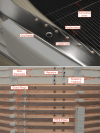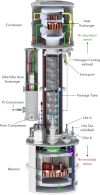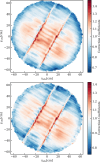The XENONnT dark matter experiment
- PMID: 39130092
- PMCID: PMC11306575
- DOI: 10.1140/epjc/s10052-024-12982-5
The XENONnT dark matter experiment
Abstract
The multi-staged XENON program at INFN Laboratori Nazionali del Gran Sasso aims to detect dark matter with two-phase liquid xenon time projection chambers of increasing size and sensitivity. The XENONnT experiment is the latest detector in the program, planned to be an upgrade of its predecessor XENON1T. It features an active target of 5.9 tonnes of cryogenic liquid xenon (8.5 tonnes total mass in cryostat). The experiment is expected to extend the sensitivity to WIMP dark matter by more than an order of magnitude compared to XENON1T, thanks to the larger active mass and the significantly reduced background, improved by novel systems such as a radon removal plant and a neutron veto. This article describes the XENONnT experiment and its sub-systems in detail and reports on the detector performance during the first science run.
© The Author(s) 2024.
Figures




















References
-
- E. Aprile et al., Design and Performance of the XENON10 Dark Matter Experiment. Astropart. Phys. 34, 679 (2011). 10.1016/j.astropartphys.2011.01.006
-
- E. Aprile et al., The XENON100 Dark Matter Experiment. Astropart. Phys. 35, 573 (2012). 10.1016/j.astropartphys.2012.01.003
-
- E. Aprile et al., The XENON1T Dark Matter Experiment. Eur. Phys. J. C 77(12), 881 (2017). 10.1140/epjc/s10052-017-5326-3
-
- E. Aprile et al., Dark Matter Search Results from a One Ton-Year Exposure of XENON1T. Phys. Rev. Lett. 121(11), 111302 (2018). 10.1103/PhysRevLett.121.111302 - PubMed
-
- E. Aprile et al., First Results on the Scalar WIMP-Pion Coupling, Using the XENON1T Experiment. Phys. Rev. Lett. 122, 071301 (2019). 10.1103/PhysRevLett.122.071301 - PubMed
LinkOut - more resources
Full Text Sources
